The Cancer Moonshot: How Winship is Working to End Cancer as We Know It

Photo: Avery Spalding
Hope surged when President Joe Biden and First Lady Jill Biden reignited the Cancer Moonshot in 2022 after it first launched in 2016. The program’s goal is to “end cancer as we know it”—reducing cancer mortality by at least 50% within the next 25 years and improving the effect of cancer on patients, their families and caregivers.
Achieving this bold vision requires a strategy. That’s exactly what the National Cancer Institute (NCI) rolled out in its comprehensive National Cancer Plan. The plan’s focus is “to achieve a society where every person with cancer lives a full and active life, and to prevent most cancers so that few people need to face this diagnosis.”
The National Cancer Plan establishes eight goals we must achieve to prevent cancer, reduce mortality from cancer and maximize quality of life for people living with cancer. The plan describes the goals as “aspirational statements, describing an ideal future, and represent opportunities for everyone and every organization to contribute to our continued progress against cancer.”
Winship’s role
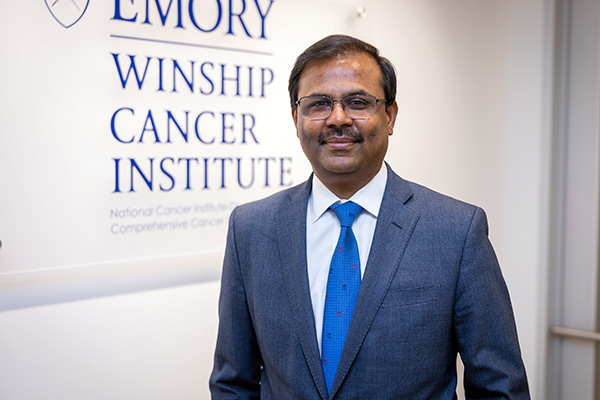
Suresh S. Ramalingam, MD
"As Georgia’s only NCI-designated Comprehensive Cancer Center, Winship already is working to end cancer as we know it," says Suresh S. Ramalingam, MD, FACP, FASCO, Winship’s executive director and the Robert C. Goizueta Chair for Cancer Research at Emory University School of Medicine. “Winship has programs, projects and centers already in place that are addressing the key objectives of the National Cancer Plan,” he says.
This isn’t coincidental. Kimberly F. Kerstann, PhD, Winship’s chief administrative officer and associate director for research administration, explains that the NCI’s Office of Cancer Centers—the entity that evaluates and supports cancer centers for NCI designation—uses its NCI designation review and approval process to “guide us in how we align our work in support of the strategic plan of the NCI.”
This process ensures that all 72 NCI-designated Cancer Centers nationwide are working toward improvements that help us accomplish the goals of reducing cancer mortality by 50% and changing the experience of cancer.
To illustrate how Winship plays an important role in helping to achieve the Cancer Moonshot, Kerstann points to the recent three-year, $24.8 million award from the new federal Advanced Research Projects Agency for Health (ARPA-H) to Winship researcher Philip Santangelo, PhD, a professor in the Wallace H. Coulter Department of Biomedical Engineering at Emory and Georgia Institute of Technology. The first-ever ARPA-H cooperative agreement will support the development of a cutting-edge programmable approach to prevent, treat and potentially cure diseases such as cancer, autoimmune disorders and infectious diseases.
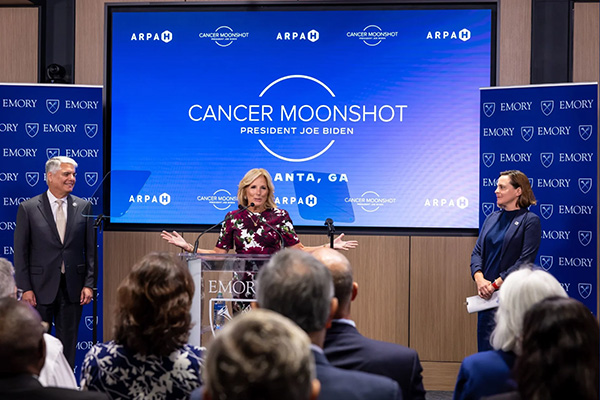
First lady Jill Biden visited Emory on Sept. 15 to learn about professor Philip Santangelo’s groundbreaking research aiming to tune the immune system to fight cancer and other diseases.
After the award was announced, First Lady Jill Biden visited Emory in September 2023 to see Santangelo’s lab, underscoring the importance of his work to the Cancer Moonshot’s goals of preventing and developing effective treatments for cancer.
Beyond the ARPA-H project, Winship’s researchers have been instrumental in developing some of the most widely used cancer treatments. Winship research has led to 145 patents for new cancer therapies, and two-thirds of today’s FDA-approved cancer treatments were available in clinical trials at Winship prior to receiving FDA approval.
Winship contributes to the National Cancer Plan’s goal of delivering optimal care by integrating its research breakthroughs into our cancer care to provide the very best care available. Each year Winship serves more than 17,000 patients newly diagnosed with cancer. The care they receive is provided by leading cancer specialists collaborating across disciplines to tailor treatment plans to their needs. They are also offered innovative therapies and clinical trials, comprehensive patient and family support services and a care experience aimed at easing the burden of cancer.
Serving and engaging a diverse state, bridging disparities
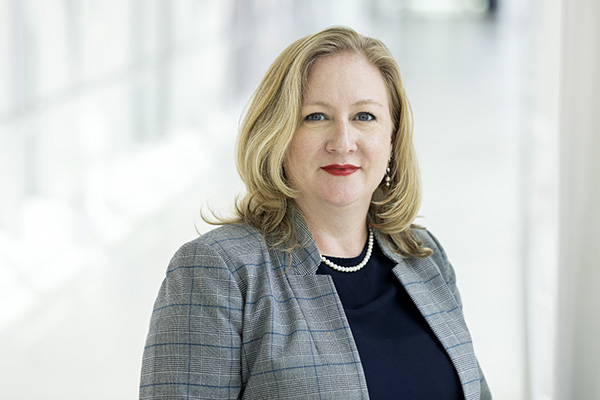
Kimberly F. Kerstann, PhD
Winship’s community is very diverse. Ramalingam notes that more than half of Georgia’s people belong to minority communities. Besides serving patients from diverse racial and ethnic backgrounds, Winship’s catchment area also includes Georgians in rural areas, given that 77% of Georgia’s landmass is defined as rural.
“Living in a very diverse state,” says Ramalingam, “we are reminded every day, during these encounters with our patients and communities, the extent of inequities that exist at various levels. We know that disparities exist not just based on race, but also on a rural vs. urban basis, and other various factors.”
Addressing these disparities—by race or ethnicity, geographic location, socioeconomic status or other factors—has long been a top priority at Winship, even before the National Cancer Plan made eliminating inequities its fourth goal.
“Our focus,” Ramalingam says, “is to eliminate inequities so everyone has access to cutting-edge advances and the opportunity to participate in research.”
Winship works actively to engage people in our research. Engaging the community in all types and phases of cancer research brings important societal issues and the lived experience of Georgians to the forefront, informing scientists in ways that lead to studies that are more responsive to the needs of Georgia communities. Engaging community members as partners in research also helps foster a collaborative and ethical foundation for scientific discovery.
To help eliminate inequities and ensure equal access to research, a philanthropic gift allowed Winship in 2023 to create the Winship Center for Cancer Health Equity Research (see below). Ramalingam says, “I think the Center will help us take our programs and research in disparities to an even higher level.”
Winship’s top prevention priorities
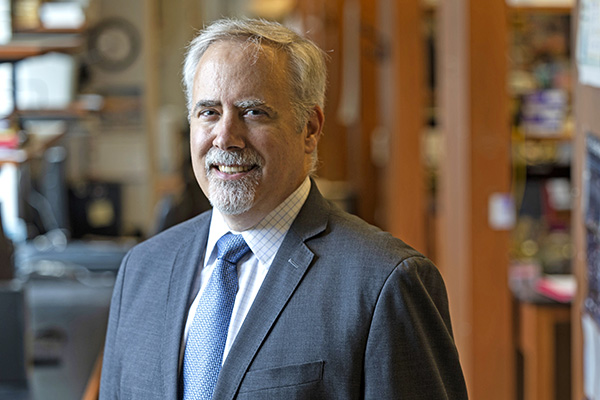
Timothy L. Lash, DSc, MPH
Lash says, “If you think about where there’s opportunities for cancer prevention, it starts with tobacco control, and especially in a state like Georgia, where tobacco prevalence is higher than in some states.” For this reason, he calls tobacco cessation Winship’s number-one focus for cancer prevention research.
Second is weight gain, which is critically important not only for preventing heart disease and diabetes but also for cancer. “Among people who are not tobacco smokers, with no history of tobacco use, excess weight is probably the most common risk factor for cancer, and it’s related to all types of cancer,” Lash says.
Third is HPV vaccination, which prevents human papillomavirus—a known risk factor for cervical cancer, head and neck cancers, oral cancers and cancers of the anus, vagina and penis. “There’s an effective vaccine, but the uptake of the vaccine is highly variable by geography,” says Lash.
A fourth top focus of Winship’s cancer prevention research is sun safety. Then there are smaller but still important risk factors, such as alcohol use and occupational hazards such as radiation and asbestos. “The American Cancer Society says that we know how to prevent 70% of cancers already,” says Lash. “We know how to prevent a lot of cancer.”
An important key to preventing a lot of late-stage cancers is regular screenings that can detect cancer early and permit intervention before they become more difficult to treat. Winship’s scientists research evidence-based interventions and programs that increase screening and early detection. Winship created the website Your Connection to Early Detection to provide Georgia residents with a comprehensive resource for finding low-cost cancer screenings in their local area.
Data are the foundation
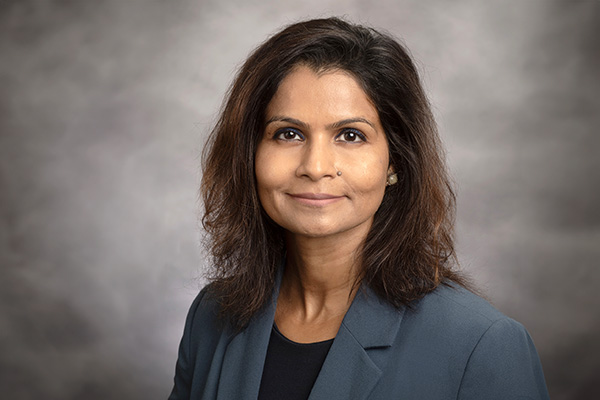
Madhusmita Behera, PhD
The data Winship collects and analyzes comes from a variety of sources—including clinical data, genomics data and imaging data. Behera says the data are important in helping to notice trends for scientific discoveries, answer research questions related to patient outcomes, patient treatment response and patient safety. “We need it for all of those critical components of cancer research and clinical care,” she says.
Behera points out that “a huge part” of the Winship clinical staff’s daily responsibilities involves accessing electronic health records (EHR) for clinical operations. “The fact that we have made it easier for accessing data of that nature makes it all the more important for how we care for our patients,” she says, adding that data also “have really allowed us to provide the opportunity for clinical trials participation to a large number of patients.”
Building a skilled, diverse workforce
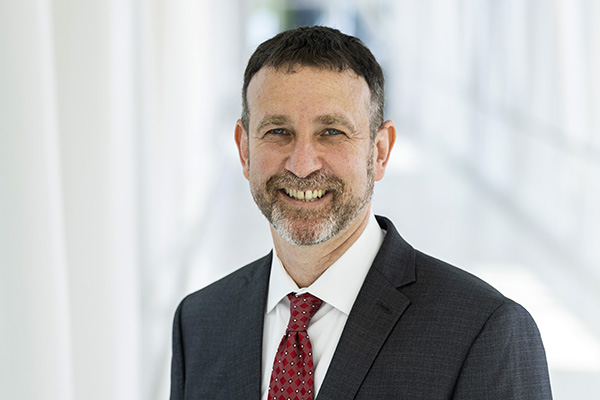
Adam Marcus, PhD
Educating and training the people who comprise Winship’s clinical and research teams has long been a priority for Winship (see the story in Winship Magazine’s Summer 2023 issue). Winship Deputy Director Adam Marcus, PhD, Winship 5K Research Professor in the Emory Department of Hematology and Medical Oncology, points to Winship’s full range of educational programs for learners of all ages and career levels. “Many of our training programs span learners of a variety of ages and a variety of steps in their career,” he says. “That’s to really ensure that we’re training the next generation and that the next generation of the health care and research workforce is indeed diverse.”
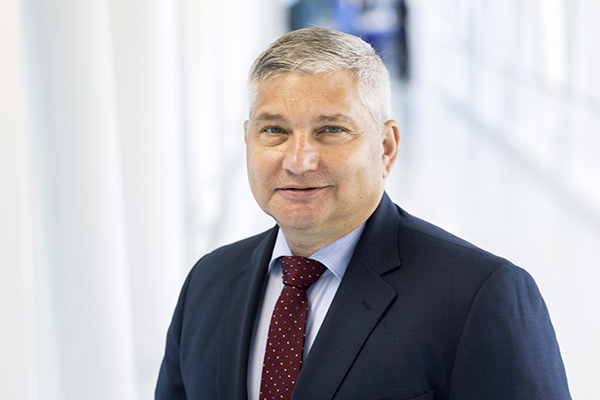
Lawrence Boise, PhD
Boise emphasizes that while it’s important to build the workforce, it’s equally important to build a diverse workforce. “We all recognize that we strengthen our opportunities by diversifying our workforce. We also recognize that students want to train with people that they can identify with, and patients often want to be seen by people they can identify with,” he says. It has to do, in part, with a “feeling of trust.”
Ildemaro J. Gonzalez, MBA, Winship’s chief diversity officer, says the NCI measures and evaluates the efforts to achieve diversity within NCI-designated Comprehensive Cancer Centers as part of its criteria for designation. “We have to show and demonstrate our efforts,” says Gonzalez. He explains that doing so entails four aims: (1) having the right infrastructure; (2) growing the pipelines of future clinicians and researchers; (3) recruiting individuals from under-represented populations; and (4) accountability.
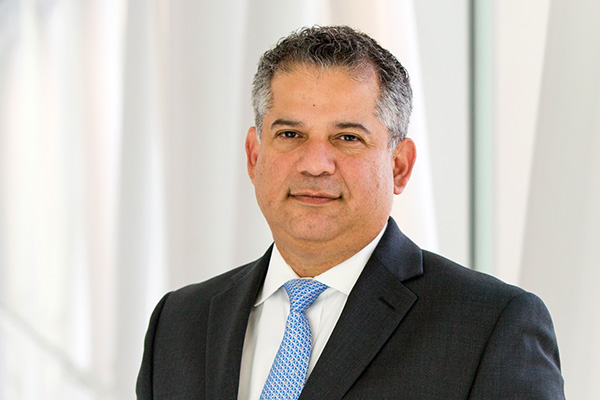
Ildemaro J. Gonzalez, MBA
Whether they are developing evidence- based cancer prevention interventions, educating future researchers and clinicians or directly caring for our patients, Winship’s workforce is dedicated to changing cancer as we know it.
As Ramalingam puts it, “Our program’s focus on cancer prevention, early detection, treatment, care, community engagement, diversifying our workforce, utilizing data and reducing inequities, and are highly aligned with the goals of the National Cancer Plan.”
New Center to Focus on Eliminating Cancer Disparities
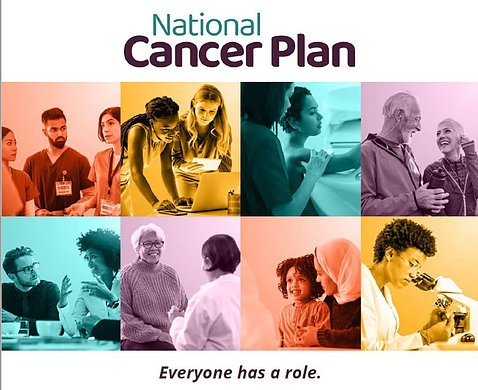
Reducing the burden of cancer and promoting cancer health equity throughout Georgia are at the heart of the mission of Winship Cancer Institute of Emory University. To support its efforts, Winship created a new Winship Center for Cancer Health Equity Research to focus on eliminating cancer disparities in Georgia and nationwide.
“Winship has a long history of working toward more equitable cancer health outcomes, and this strategic focus will accelerate our efforts in significant ways,” says Suresh S. Ramalingam, MD, Winship’s executive director.
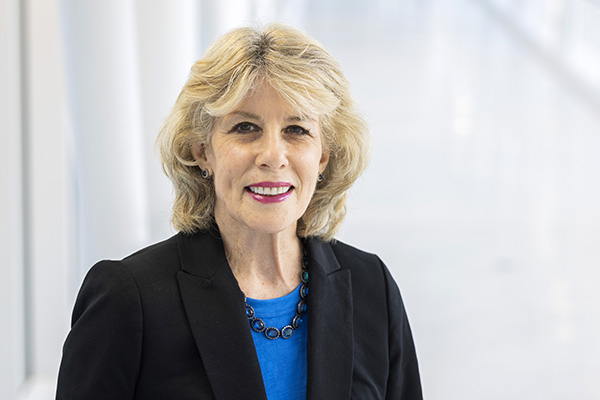
Theresa W. Gillespie, PhD
The center is made possible by generous gifts from the Wilbur and Hilda Glenn Family Foundation and Southern Company. It will address cancer disparities by examining biological, behavioral and social factors affecting cancer development, risk and response to therapy. It will fund new studies, strengthen collaborations and improve representation in Winship’s clinical trials.
Unique focus on research across the continuum and cost of interventions
Winship’s center will be unique in two ways among the nation’s cancer centers that have developed their own centers focused on cancer health equity. First, the center will focus on research across the entire continuum of cancer research. Gillespie says, “This means that the center encourages investigators to pursue basic, translational, clinical and population science research examining underlying basic mechanisms, factors that impact and viable solutions related to cancer health equity.”
Second, the center will focus on the costs and cost-effectiveness of interventions in order to promote policy changes. “Often,” says Gillespie, “interventions or therapeutics are not always concerned about the costs or cost-effectiveness.” Although they provide good measures of how well resources are being used to produce the desired outcome—reducing the burden of cancer—Gillespie says costs and cost-effectiveness “are often not included in many research studies.” This is despite the fact that, “policy changes may be dependent on demonstrating how much certain interventions may cost and, most importantly, how cost-effective they are and how well they contribute to the key outcomes in cancer.”
The center also will be different by intentionally incorporating a variety of perspectives in its research and the interventions it develops—perspectives from the community, patients, health care providers and disciplines across the continuum of cancer research. This will allow study of the underlying causes of cancer disparities, including basic science mechanisms, and opportunity to design creative approaches to reduce them.
“Winship is ‘Where Science Becomes Hope,’” says Gillespie. “The Winship Center for Cancer Health Equity Research will focus on this important research related to reducing cancer disparities and promoting cancer health equity to find ways to ensure that the science is equitable and the hope is accessible to all people in Georgia, and beyond.”




